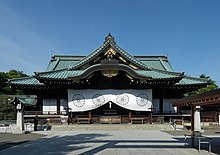
Back ضريح ياسوكوني Arabic ضريح ياس و كونى ARZ Yasukuni məbədi Azerbaijani Ясукуні Byelorussian Santual Yasukuni Breton Santuari Yasukuni Catalan Svatyně Jasukuni Czech Ясукуни храмĕ CV Yasukuni-helligdommen Danish Yasukuni-Schrein German
| Yasukuni Shrine | |
|---|---|
靖国神社 Yasukuni Jinja | |
 The haiden (hall of worship) | |
| Religion | |
| Affiliation | Shinto |
| Festival | |
| Type | Chokusaisha (former bekkaku-kanpeisha) |
| Location | |
| Location | 3-1-1 Kudankita, Chiyoda, Tokyo 102-8246 |
| Geographic coordinates | 35°41′38″N 139°44′34″E / 35.693958°N 139.742692°E |
| Architecture | |
| Style | Shinmei-zukuri, copper roofing (dōbanbuki) |
| Founder | Emperor Meiji |
| Date established | June 1869 |
| Website | |
| www | |
Yasukuni Shrine (靖国神社 or 靖國神社, Yasukuni Jinja, lit. 'Peaceful Country Shrine') is a Shinto shrine located in Chiyoda, Tokyo. It was founded by Emperor Meiji in June 1869 and commemorates those who died in service of Japan, from the Boshin War of 1868–1869, to the two Sino-Japanese Wars, 1894–1895 and 1937–1945 respectively, and the First Indochina War of 1946–1954, including war criminals.[1] The shrine's purpose has been expanded over the years to include those who died in the wars involving Japan spanning from the entire Meiji and Taishō periods, and the earlier part of the Shōwa period.[2]
The shrine lists the names, origins, birthdates, and places of death of 2,466,532 people.[2] Among those are 1066 convicted war criminals, twelve of whom were charged with Class A crimes (the planning, preparation, initiation, or waging of the war); eleven were convicted on those charges with the twelfth found not guilty on all such charges though he was found guilty of Class B war crimes. The names of two more men charged with Class A war crimes are on the list but one died during trial and one before trial so they were never convicted. This has led to many controversies surrounding the shrine. Another memorial at the Honden (main hall) building commemorates anyone who died on behalf of Japan, and so includes Koreans and Taiwanese who served Japan at the time. In addition, the Chinreisha ("Spirit Pacifying Shrine") building is a shrine built to inter the souls of all the people who died during World War II, regardless of their nationality. It is located directly south of the Yasukuni Honden.
Japanese soldiers fought World War II in the name of Emperor Shōwa, who visited the shrine eight times between the end of the war and 1975.[3] However, he stopped visiting the shrine due to his displeasure over the enshrinement of top convicted Japanese war criminals.[4] His successors Akihito and Naruhito have never visited the shrine.[5]
- ^ "History". Yasukuni.or.jp. Retrieved 2016-03-03.
- ^ a b "Deities". Yasukuni.or.jp. Archived from the original on 2016-06-24. Retrieved 2008-04-13.
- ^ "Explainer: Why Yasukuni shrine is a controversial symbol of Japan's war legacy". Reuters. 14 August 2021.
- ^ "Hirohito quit Yasukuni Shrine visits over concerns about war criminals". The New York Times. 26 April 2007.
- ^ "Explainer: Why Yasukuni shrine is a controversial symbol of Japan's war legacy". Reuters. 14 August 2021.
© MMXXIII Rich X Search. We shall prevail. All rights reserved. Rich X Search
